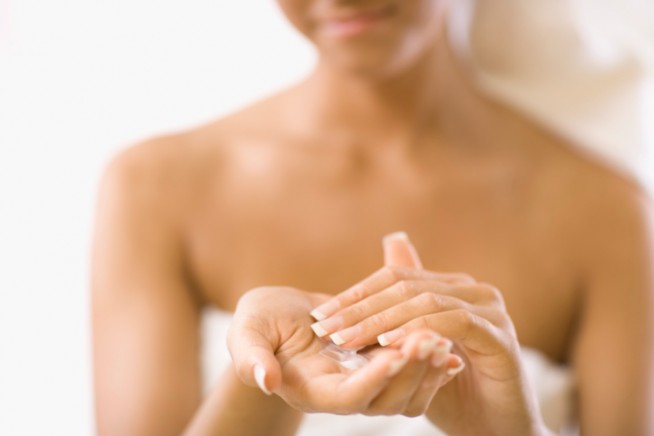This list was taken from my book REVIVE: Stop Feeling Spent and Start Living Again.
DEA (Diethanolamine), MEA (Monoethanolamine), TEA (Triethanolamine)
These three chemicals are hormone-disrupting chemicals that can form cancer-causing agents—research indicates a strong link to liver and kidney cancer. They are commonly found in shampoos, soaps, bubble baths, and facial cleansers.
Phthalates and Parabens
Banned by the European Union in 2003, phthalates and parabens are a group of chemicals commonly used as preservatives in cosmetics and pharmaceuticals. They keep hairsprays sticky and bacteria and fungus out of things like nail polish and perfume. Both have demonstrated themselves to be carcinogenic and particularly linked to breast cancer.
FD&C Color Pigments
Most FD&C color pigments are made from coal tar and studies show that almost all of them are carcinogenic. Many of these pigments cause skin sensitivity and irritation, or even oxygen depletion in the blood. FD&C Red #4 is no longer available for use in foods because of a known threat to the adrenal glands and urinary bladder.
Fragrance
“Fragrance” is a euphemism for nearly 4,000 different ingredients. Most “fragrances” are synthetic and are either cancer-causing or otherwise toxic. Exposure to fragrances has been shown to affect the central nervous system. “Fragrances” are found in most shampoos, deodorants, sunscreens, skincare and body care products.
Imidazolidinyl Urea and DMDM Hydantoin
These are formaldehyde donors, which means that they are derivatives of the formaldehyde, which is what scientists and morticians use to preserve corpses and body parts. Remember dissecting frogs in school? These chemicals are linked to allergies, chest pain, chronic fatigue, depression, dizziness, ear infections, headaches, joint pain, loss of sleep, and can trigger asthma. They can weaken the immune system, and—surprise surprise—cause cancer. Imidazolidinyl Urea and DMDM Hydantoin are used in skin, body and hair products, antiperspirants, and nail polish.
Quaternium-15
Quarternium-15 commonly causes allergic reactions and dermatitis, and breaks down into formaldehyde. Quarternium-15 is used as a preservative in many skin and hair care products.
Isopropyl Alcohol
Isopropyl Alcohol is used in hair color rinses, body rubs, hand lotion, and aftershave lotions as well as in your car’s antifreeze and shellac! Scientists believe that it has the ability to destroy intestinal flora, leaving the body’s major organs open to parasites, and thus to cancers. Beyond attacking the intestinal flora, isopropyl alcohol can cause headaches, dizziness, mental depression, nausea, vomiting, and coma.
Mineral Oil
Mineral oil is a petroleum derivative that coats the skin like Saran Wrap, which prevents the skin from breathing, absorbing, and excreting. It also slows the skin’s natural cell development, causing the skin to age prematurely. Note that baby oil is 100% mineral oil—and 100% bad for your baby’s sensitive skin.
PEG (Polyethylene Glycol)
PEGs are most commonly used in spray-on oven cleaners and in many hair and skin products. PEG’s main fuctions are to dissolve oil and grease. Thus, on the body, they take the protective oils off the skin and hair, making them more vulnerable to other toxins.
Propylene Glycol
Propylene Glycol is the active ingredient in antifreeze. It is also used in makeup, toothpaste, and deodorant. Stick deodorants have a higher concentration of PG than is allowed for most industrial use! Direct contact can cause brain, liver, and kidney abnormalities. The EPA requires workers to wear protective gloves, clothing, and goggles when working with it. And yet, the FDA says we can put it in our mouths!
Sodium Lauryl Sulfate and Sodium Laureth Sulfate
Sodium Lauryl Sulfate and Sodium Laureth Sulfate are the most toxic ingredients on this list. When used in combination with other chemicals, they can form nitrosamines, a deadly class of carcinogen. They are used to clean engines, garage floors, and at car washes. AND still the most popular ingredients for makeup, shampoo and conditioner, and toothpaste. Exposure causes eye damage, depression, diarrhea, and many other ailments.
Triclosan
A synthetic antibacterial ingredient that has been compared to Agent Orange. The Environmental Protection Agency registers it as a pesticide, highly toxic to any living organism. It is also classified as a chlorophenol. In other words, it is in a cancer-causing chemical class. Triclosan disrupts hormones, can affect sexual function and fertility, and may foster birth defects. Triclosan has been linked to paralysis, suppression of the immune system, brain hemorrhages, and heart problems. It is widely used in antibacterial cleansers, toothpaste, and household products.
Talc
Talc has been linked to ovarian and testicular cancer. It can be found in makeup, baby and adult powders, and foundation.
Petrolatum
Petrolatum is a petrochemical that contains two well-known carcinogens: Benzo-A-Pyrene and Benzo-B-Fluroanthene. As you might imagine from a petroleum derivative, petrolatum prevents the skin from breathing and excreting.
Dr. Frank Lipman is an acclaimed Integrative Physician and the founder and director of the Eleven Eleven Wellness Center in New York City. For over 20 years his personal brand of healing has helped thousands of people reclaim their vitality and recover their zest for life. Focused on sustainable wellness—instead of quick fixes—he offers patients a customized blend of Western medicine with acupuncture, nutritional counseling, vitamins and herbs, relaxation techniques, physical therapy, and bodywork. In 2010 he developed Be Well by Dr. Frank Lipman, a line of leading-edge supplements and health programs. He is the author of Revive: Stop Feeling Spent and Start Living Again and Total Renewal: 7 Key Steps to Resilience, Vitality and Long-Term Health.
For more on Dr. Lipman, please visit his resourceful WEBSITE or on FACEBOOK or TWITTER.












